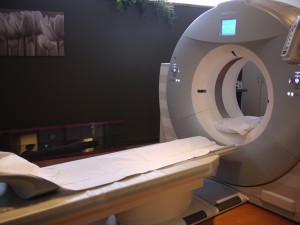And exposure to high levels of radiation has been linked to cancer.
Despite the potential dangers, fewer than half of the parents who bring their children into emergency rooms are aware of the cancer risks from CT scans, according to a study published today in the journal Pediatrics.
“Clearly there is a gap in the truth about the radiation risks and parental understanding,” said Phelps, who was not involved with the study.
Although the potential risk to any individual is small, multiple exposures or high doses of radiation may increase the risk of cancer later in life. What’s more, the developing bodies of children may be even more sensitive to radiation than adults.
In the study researchers surveyed parents arriving in Canadian emergency rooms with kids who had suffered head injuries. The researchers found that roughly 90 percent of parents were “very willing/willing” to have a CT scan done on their child.
The use of CT scans in diagnosing kids has grown dramatically in the past decades. One previous study of U.S. health centers found that the number of scans in kids younger than age 5 had doubled from 1995 to 2005. During the same period, the number of scans tripled for children ages 5-14. Other research of CT scans in emergency rooms, has found that the increase was even higher: CT scans in kids increased fivefold from 1995 to 2008, growing from 0.33 to 1.65 million.
Since 2007, studies suggest that the use of CT in children has declined. At pediatric hospitals, more doctors are prescribing ultrasounds or MRIs, which are less risky, said Phelps.
“But about half of all pediatric imaging occurs in non-pediatric imaging centers,” he said, adding that children who get tests at places that cater to adults may not always be getting “kid-sized” doses.
Many physicians credit much of the decrease in the number of CT scans in recent years to the Image Gently campaign by the Alliance for Radiation Safety in Pediatric Imaging. The campaign advocates for doing tests only when they are medically necessary and then to use the smallest amount of radiation possible.
“The purpose is to educate the pediatricians and the general practitioners before you order a test,” said Bernice Law, a pediatric radiologist at California Pacific Medical Center.
The campaign encourages parents to be proactive and ask physicians if a test is medically necessary.
In the Canadian study, researchers found that a clear discussion of risks and benefits makes a difference to parents. After these conversations, the number of parents willing to approve a CT scan in their child dropped from 90 to almost 70 percent. In addition, more than 90 percent of all the parents -- including those who still wanted the scan -- wanted to know the risks before the tests were done.
Back in the emergency room at Lake Tahoe, Lynch didn’t know a lot about the risks of a CT scan but she did know that something was wrong with her son. “You can see that your kid is in distress,” she said. “Here’s an immediate problem versus a potential future problem.”
She and her husband asked the hospital staff about alternatives and ways to minimize the amount of radiation from the CT scan. But she says she felt pressure by some staff to do the test right away. “I will say that we really had to pull that information out of them,” Lynch says.
When a more senior doctor arrived in the emergency room, he explained the risks and benefits of the procedure with Lynch and her husband. “The doctor there was fabulous because he gave us a lot of information, and it felt like we were making a very informed decision,” said Lynch.
As Lynch was signing the paperwork to consent to the CT scan, her groggy son suddenly began to perk up. He started to uncurl his body and speak normally. In the end, he didn’t get a CT scan.
But, like many parents in the Canadian study, Lynch said that she appreciated a doctor walking her through all the risks and benefits of the test.
 Mary Kathryn Lynch stood next to her young son in a Lake Tahoe emergency room. The Oakland resident had rushed her 9-year-old to the hospital after a ski accident left him groggy, curled up in the fetal position, and speaking incoherently.
Mary Kathryn Lynch stood next to her young son in a Lake Tahoe emergency room. The Oakland resident had rushed her 9-year-old to the hospital after a ski accident left him groggy, curled up in the fetal position, and speaking incoherently.